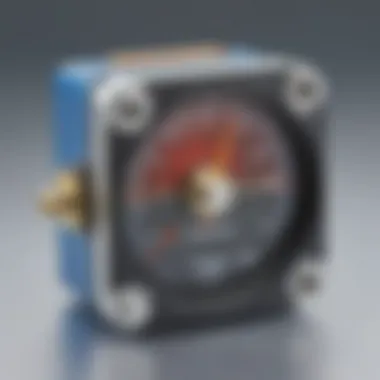Unveiling the Intricacies of Accelerometers: Measurements Explored


Science Fun Facts
Accelerometers, an intriguing topic in the realm of science, possess a myriad of interesting facts and trivia waiting to be unraveled. Did you know that accelerometers can measure both magnitude and direction of proper acceleration? This vital sensor plays a pivotal role in various fields, providing crucial data for analysis and research.
Discover the Wonders of Science
Upon delving into the world of accelerometers, one is met with the awe-inspiring range of scientific concepts at play. From Newton's laws of motion to the intricate workings of sensors, there is an abundance of educational resources available to enhance one's understanding. Additionally, real-life applications of accelerometers in areas like aerospace, automotive engineering, and sports science exemplify the practical importance of these sensors.
Science Quiz Time
To truly internalize the essence of accelerometers, engaging with interactive quizzes and brain teasers can be immensely beneficial. Test your knowledge on acceleration, forces, and sensor technology through thought-provoking questions that stimulate critical thinking. By gamifying the learning process, both kids and adults can deepen their understanding of this fundamental scientific instrument.
Science Experiment Showcase
Embark on a hands-on exploration of accelerometers through captivating experiments that unveil the sensor's functionality. By following step-by-step instructions and adhering to safety tips, individuals can conduct experiments to comprehend how accelerometers measure acceleration. With a materials list provided, aspiring scientists can engage in immersive learning experiences and gain practical insights into the world of sensor technology.
Introduction to Accelerometers
Accelerometers play a vital role in modern technology, enabling the measurement of proper acceleration accurately. In this section, we will delve into the fundamental aspects of accelerometers and their significance in various industries and research fields. By understanding the basics of accelerometers, we can grasp their essential functions and applications.
Definition and Basics
Accelerometers definition
Accelerometers are sensors designed to measure proper acceleration, indicating changes in velocity over a period. These devices detect movement and acceleration in multiple directions, making them versatile tools in engineering and scientific applications. The unique feature of accelerometers lies in their ability to convert physical movement into electrical signals, providing valuable data for analysis and assessment within different contexts.
Principle of operation
The principle of operation for accelerometers revolves around internal mechanisms such as piezoelectric, MEMS (Micro-Electro-Mechanical Systems), or piezoresistive elements. These components react to acceleration forces by generating electrical signals proportional to the detected movement. This operational principle ensures high sensitivity and responsiveness in measuring acceleration, making accelerometers reliable instruments for a wide range of purposes.
Types of Accelerometers
MEMS accelerometers
MEMS accelerometers, based on Micro-Electro-Mechanical Systems technology, offer compact design and high precision in detecting accelerations. Their small size and low power consumption make them ideal for portable devices and intricate systems where space is limited. MEMS accelerometers excel in applications requiring precise motion detection at a smaller scale.
Piezoelectric accelerometers


Piezoelectric accelerometers function by converting mechanical stress into electrical charge, providing accurate acceleration measurements with quick response times. These sensors are highly sensitive to dynamic acceleration forces, offering detailed insights into rapid movements and vibrations. The unique feature of piezoelectric accelerometers lies in their ability to capture transient events and high-frequency vibrations with exceptional clarity.
Piezoresistive accelerometers
Piezoresistive accelerometers detect acceleration by changes in electrical resistance, offering robustness and stability in various environments. These sensors exhibit excellent bandwidth and linearity, making them suitable for dynamic measurements in research and industrial settings. The advantage of piezoresistive accelerometers lies in their durability and adaptability to harsh conditions, ensuring reliable performance in demanding applications.
Importance of Accelerometers
Role in various industries
Accelerometers play a crucial role in numerous industries, including automotive, aerospace, and consumer electronics, where precise motion measurements are essential. By providing real-time data on acceleration, these sensors contribute to improving efficiency, safety, and performance in various operational environments. The key characteristic of accelerometers in industries is their ability to enhance product design and functionality by incorporating accurate motion sensing capabilities.
Significance in research and development
Accelerometers have a significant impact on research and development activities by facilitating data collection and analysis in scientific experiments and technological advancements. These sensors enable researchers to monitor and study motion dynamics, structural vibrations, and physical interactions with a high level of precision. The importance of accelerometers in research and development lies in their ability to drive innovation and discovery through insightful acceleration data interpretation.
Functionality of Accelerometers
The segment on the Functionality of Accelerometers within this article serves as a crucial exploration into the operational aspects of these sensors. Understanding how accelerometers function is vital in comprehending their role in various industries and applications. By detailing the intricate workings of accelerometers, readers can grasp the significance of these sensors in measuring proper acceleration accurately. This section will delve into specific elements such as sensor precision, calibration methods, and real-world implications, providing a comprehensive overview of accelerometer functionality.
Measuring Proper Acceleration
Acceleration vs. Velocity
The distinction between Acceleration and Velocity is a fundamental concept in the realm of accelerometers. While Velocity refers to the rate of change of an object's position over time, Acceleration pertains to the rate of change of its velocity with respect to time. This differentiation holds immense importance as accelerometers specifically measure Proper Acceleration, which includes both the magnitude and direction of acceleration. Understanding this distinction is pivotal in utilizing accelerometers effectively for various applications, offering precise measurements of acceleration dynamics.
Magnitude and Direction
Measuring the Magnitude and Direction of acceleration is a key feature of accelerometers in capturing comprehensive data. The magnitude denotes the intensity of acceleration, while the direction indicates the orientation in which the acceleration is acting. By incorporating sensors that can detect both magnitude and direction, accelerometers provide detailed insights into motion patterns and changes. This capability allows for a nuanced analysis of acceleration trends, aiding in diverse fields such as engineering, biomechanics, and transportation.
Understanding Sensor Data
Raw data interpretation
Interpreting Raw sensor data is a critical aspect of utilizing accelerometers effectively. Raw data comprises the initial output received from the sensor, which requires processing and analysis for meaningful insights. This process involves decoding the signal into actionable information, understanding noise levels, and extracting relevant acceleration measurements. Effective raw data interpretation enhances the accuracy and reliability of accelerometer readings, optimizing performance across various applications.
Calibration techniques


Implementing Calibration techniques is essential for maintaining the accuracy and consistency of accelerometer readings over time. Calibration involves adjusting the sensor to ensure its output aligns with known standards or references. By calibrating accelerometers using precise techniques and standards, users can mitigate errors, improve measurement reliability, and validate data across different conditions. Calibration plays a significant role in enhancing the overall functionality and relevance of accelerometers in research, industrial, and consumer settings.
Applications Across Industries
Automotive
The application of accelerometers in the Automotive industry is substantial, with sensors being utilized in vehicle safety systems, performance monitoring, and impact testing. By integrating accelerometers into vehicles, engineers can gather data on acceleration forces during maneuvers, brake applications, and collisions. This data is crucial for assessing vehicle stability, optimizing safety features, and enhancing overall driving experience. The Automotive sector heavily relies on accelerometer technology for research, development, and implementation of advanced driver assistance systems.
Aerospace
Aerospace industry leverages accelerometers for diverse applications such as spacecraft navigation, aircraft instrumentation, and structural health monitoring. Accelerometers play a pivotal role in measuring gravitational forces, detecting vibrations, and monitoring flight dynamics. By incorporating accelerometers into aerospace systems, engineers can ensure precise navigation, stability control, and performance optimization. These sensors are instrumental in enhancing flight safety, operational efficiency, and structural integrity in aerospace operations.
Consumer Electronics
In the realm of Consumer Electronics, accelerometers find broad utility in devices like smartphones, smartwatches, and gaming consoles. These sensors enable functionalities such as screen rotation, gesture recognition, and activity tracking in various electronic gadgets. By embedding accelerometers, manufacturers enhance user experience, improve device interaction, and enable innovative features. Consumer Electronics benefit significantly from accelerometer technology by offering interactive and dynamic capabilities that enrich user engagement and utility.
Role of Accelerometers in Everyday Life
In this section of the article, we delve into the crucial role that accelerometers play in our daily lives. Understanding the impact of accelerometers in everyday life is paramount, as these sensors are embedded in various devices we use regularly. From smartphones to fitness trackers, accelerometers enable numerous functionalities that enhance user experiences and provide valuable data. Without accelerometers, tasks like automatic screen rotation and fitness tracking would not be possible on a seamless level. Their significance goes beyond mere convenience, extending to areas such as health monitoring and athletic training optimization.
Impact on Wearable Technology
Activity Tracking
Exploring the realm of activity tracking through accelerometers offers a profound perspective. The meticulous monitoring of movements and physical activities becomes achievable due to the intricate technology within these sensors. Activity tracking utilizing accelerometers allows not only the measurement of steps taken but also calculates distances traveled and calories burnt. Such detailed data aids individuals in tracking their fitness progress and maintaining a healthy lifestyle. The real-time feedback provided by activity tracking accelerometers serves as a motivating factor for many users, encouraging them to achieve their fitness goals effectively.
Health Monitoring
The crucial role of accelerometers in health monitoring cannot be overstated. These sensors enable the monitoring of vital signs and physical activities for health-related purposes. Tracking parameters like heart rate, sleep quality, and stress levels using accelerometers provides valuable insights into an individual's overall well-being. The integration of accelerometers in wearable health devices has revolutionized the healthcare industry by allowing continuous monitoring outside clinical settings. Despite its numerous benefits, the accuracy and calibration of health monitoring accelerometers require precise attention to ensure reliable data interpretation.
Integration in Smartphones
Gaming Applications
Accelerometers incorporated within smartphones have opened up a realm of interactive gaming experiences. The utilization of these sensors enables gesture-based control in games, immersing users in a dynamic virtual environment. By simply tilting or rotating the device, users can interact with games intuitively, enhancing the gaming experience. However, the accuracy and sensitivity of accelerometer data are crucial for optimal gaming performance, as any discrepancies may affect gameplay.
Screen Orientation


One of the fundamental features empowered by accelerometers in smartphones is automatic screen orientation adjustment. The ability to automatically switch between portrait and landscape modes based on device orientation enhances user convenience during various tasks. Accelerometer-based screen orientation also plays a vital role in ensuring a seamless user interface across different applications, providing an immersive and comprehensive user experience.
Advancements in Health and Fitness
Biomechanics Analysis
Accelerometers have revolutionized biomechanics analysis in health and fitness by enabling precise motion monitoring. Through the collection of acceleration and orientation data, accelerometers offer valuable insights into body movements during physical activities. Biomechanics analysis using accelerometers aids in optimizing training routines, enhancing athletic performance, and preventing injuries. The detailed information provided by these sensors contributes significantly to the understanding of human movement patterns and biomechanical efficiency.
Training Optimization
Accelerometers integrated into fitness devices have transformed the landscape of training optimization. The real-time feedback obtained from these sensors allows individuals to tailor their workout routines based on accurate data. Training optimization through accelerometers involves analyzing performance metrics such as exertion levels, repetition counts, and exercise effectiveness. By leveraging accelerometer data, individuals can enhance their training efficiency, set achievable fitness goals, and track progress systematically.
Future Prospects and Innovations
In this section, we delve into the realm of future prospects and innovations related to accelerometers. It is essential to understand the trajectory of technological advancements to grasp the potential developments in this field. By focusing on the upcoming innovations, we can anticipate the impact of emerging trends on various industries.
Miniaturization and Efficiency
Nano-scale accelerometers
Nano-scale accelerometers represent a groundbreaking advancement in sensor technology. These accelerometers are characterized by their minuscule size, allowing for integration into compact devices with unprecedented precision. The key benefit of nano-scale accelerometers lies in their ability to provide high accuracy in measuring even the slightest accelerations. Despite their diminutive stature, nano-scale accelerometers offer remarkable sensitivity, making them a popular choice for applications requiring precise motion detection and analysis.
Power consumption reduction
Power consumption reduction is a pivotal aspect of enhancing the efficiency of accelerometers. By optimizing power usage, these sensors can operate for extended periods without draining resources. This feature is particularly advantageous in battery-powered devices where energy efficiency is paramount. The unique feature of power consumption reduction in accelerometers is its ability to prolong device longevity while maintaining consistent performance. Although reducing power consumption is beneficial, it may lead to trade-offs in sensor responsiveness which must be carefully balanced for optimal functionality.
Integration with IoT and AI
Smart city applications
The integration of accelerometers with Internet of Things (Io T) and Artificial Intelligence (AI) systems opens up a plethora of smart city applications. By incorporating accelerometers into urban infrastructure, cities can gather real-time data on traffic patterns, infrastructure health, and environmental conditions. The key characteristic of smart city applications leveraging accelerometers is their role in creating dynamic and responsive city systems. This synergy enhances decision-making processes and enables efficient resource management in urban environments. However, the reliance on accelerometers for crucial city functions raises concerns about data privacy and system security that need to be addressed for sustainable deployment.
Predictive maintenance
Predictive maintenance, facilitated by accelerometer technology integrated with Io T and AI, revolutionizes asset management practices. By monitoring equipment vibrations and performance metrics in real-time, predictive maintenance systems can predict potential failures before they occur, enabling proactive maintenance strategies. The key characteristic of predictive maintenance is its predictive analytics capabilities, which enable cost-effective maintenance planning and reduced downtime. Despite its advantages in optimizing maintenance schedules and improving operational efficiency, predictive maintenance systems require robust data connectivity and analysis frameworks to deliver accurate insights.
Emerging Trends and Research Areas
Biomedical engineering
The intersection of accelerometers with biomedical engineering opens up innovative possibilities for healthcare and medical research. Accelerometers play a pivotal role in wearable health technology, facilitating monitoring of patient movements, activity levels, and physiological parameters. The key characteristic of accelerometers in biomedical engineering is their non-invasive nature and ability to provide real-time health data for diagnostic and therapeutic applications. While accelerometers enhance personalized healthcare interventions and enable remote patient monitoring, challenges exist in ensuring data accuracy and patient compliance within clinical settings.
Autonomous vehicles
Accelerometers serve as integral components in the development of autonomous vehicles, contributing to their navigation and control systems. The key characteristic of accelerometers in autonomous vehicles is their role in providing accurate motion and orientation data for vehicle dynamics and trajectory calculations. By integrating accelerometers with GPS and other sensor technologies, autonomous vehicles can achieve precise localization and navigation capabilities. Despite the potential advantages of accelerometers in autonomous vehicles, ensuring sensor reliability and redundancy mechanisms is critical for enhancing passenger safety and system robustness.







